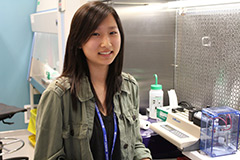A good impression
By Alisa Kim
When Julia Kim contacted Dr. Charles Cunningham about the possibility of volunteering in his lab this summer, she didn’t get the response she had hoped for.
It was something better.
Cunningham, an imaging physicist at Sunnybrook Research Institute (SRI), told Kim he couldn’t accept volunteers but encouraged her to apply to the D+H SRI Summer Student Research Program.
Kim, a second-year life sciences student at the University of Toronto, was accepted into the program and joined the Cunningham group in May. Kim is applying her background in biology to further the lab’s research into metabolic imaging of cancer using a new contrast agent for magnetic resonance imaging.
“Instead of using protons [from water] to detect signals from the body, they’re using hyperpolarized carbon-13 [labeled] pyruvate. Pyruvate is used in the body pretty fast so we can see how pyruvate changes into lactate, which is one of the hallmarks of tumour mass because they tend to release lactate,” says Kim.
She is developing beads made out of a biopolymer that can act as a housing unit for the cancer cells. The pyruvate, which will be ordered from a supplier, will be injected into the beads so the group can study the ensuing metabolic reactions occurring within the cells.
“It’s a bioreactor system we’re building,” says Kim. “They will inject the hyperpolarized carbon-13 pyruvate inside the bead so that when the cells take in the pyruvate, they can release lactate and they can see whether the pyruvate is up to standard. What I’m supposed to do is make sure that the cells and beads are reproducible so that whatever changes they see, whatever the results are, [we know they] are only due to the pyruvate, not the cells or beads.”
This is Kim’s first time working in a lab. She spent her first few weeks working on the beads to ensure that they are the same size and shape, and that the cells can grow inside them consistently without the beads degrading.
She says the experience has helped dispel romanticized views of scientific discovery she had held. “In school you learn about successful experiments, but you don’t learn how important reproducibility is and all the hard effort that goes into a successful project. I struggled the first month doing the same things over and over again, and that’s what led me to understand the process is very slow,” she says.
Despite this challenge, Kim says working in research “is an experience I will cherish.” She carries out her work independently but says Cunningham, whose office is down the hall from her lab bench, is available should any questions arise.
In addition to Cunningham, Kim can consult any of the other lab members for guidance. In particular, she discusses her progress with a PhD student who oversees her work and helps Kim fill in any knowledge gaps in physics. She says the experience has been quite beneficial in part because she has made contacts with people who have given her a glimpse into careers in academic research.
“What I wanted to do by being a research summer student is see if I like research. I was deciding between going to medical school or [doing] research. I think it’s helped me gain knowledge into how I’m going to decide between the two.”



